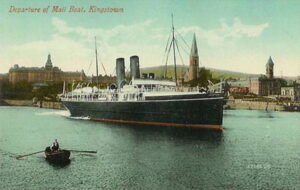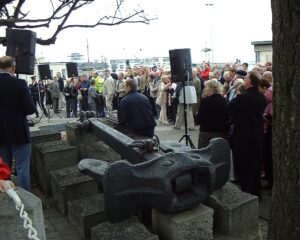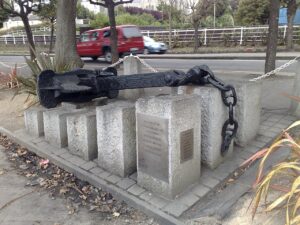 The RMS Leinster was an Irish ship, which served as the Kingstown-Holyhead mailboat and was operated by the City of Dublin Steam Packet Company. In 1895, the City of Dublin Steam Packet Company ordered four steamers for Royal Mail service, named for four provinces of Ireland. The ships were RMS Leinster, RMS Connaught, RMS Munster, and RMS Ulster. The Leinster was a 3,069-ton packet steamship with a service speed of 23 knots. The ship was built at Laird’s in Birkenhead, England. It had two independent four-cylinder triple-expansion steam engines. She has launched September 12, 1896. In a perfect world, guns would not be needed on a mail ship. Then, during the World War I, the twin-propellered ship was armed with one 12-pounder and two signal guns. The war made this protection necessary. Even with the guns for protection, RMS Leinster, like her sister ships, was vulnerable to the ever present and dangerous German U-Boats. The ship continued her run, until she found herself in the wrong place at the wrong time. RMS Leinster was torpedoed and sunk by the German U-Boat U-123, on October 10, 1918. She sank just outside Dublin Bay at a point 4 nautical miles east of the Kish light.
The RMS Leinster was an Irish ship, which served as the Kingstown-Holyhead mailboat and was operated by the City of Dublin Steam Packet Company. In 1895, the City of Dublin Steam Packet Company ordered four steamers for Royal Mail service, named for four provinces of Ireland. The ships were RMS Leinster, RMS Connaught, RMS Munster, and RMS Ulster. The Leinster was a 3,069-ton packet steamship with a service speed of 23 knots. The ship was built at Laird’s in Birkenhead, England. It had two independent four-cylinder triple-expansion steam engines. She has launched September 12, 1896. In a perfect world, guns would not be needed on a mail ship. Then, during the World War I, the twin-propellered ship was armed with one 12-pounder and two signal guns. The war made this protection necessary. Even with the guns for protection, RMS Leinster, like her sister ships, was vulnerable to the ever present and dangerous German U-Boats. The ship continued her run, until she found herself in the wrong place at the wrong time. RMS Leinster was torpedoed and sunk by the German U-Boat U-123, on October 10, 1918. She sank just outside Dublin Bay at a point 4 nautical miles east of the Kish light.
The ship had, in addition to its crew, a number of civilian mail workers. The exact number of dead is unknown, but researchers from the National Maritime Museum believe it was at least 564. The ship’s log, however, states that she carried 77 crew and 694 passengers on her final voyage. This number would seem more correct to me simply because of the records normally kept in logbooks. There is someone assigned to keep that log, and while they could have done a poor job, it is more unlikely that just trusting the number to a random guess of a historian who came along later. The sinking wasn’t the first attack that had been waged on RMS Leister. She had been previously attacked in the Irish Sea, but the torpedoes missed their target. On October 10, 1918, the manifest included more than 100 British civilians, 22 postal sorters (working in the mail room) and almost 500  military personnel from the Royal Navy, British Army, and Royal Air Force. Also aboard were nurses from Great Britain, Ireland, Australia, New Zealand, Canada, and the United States.
military personnel from the Royal Navy, British Army, and Royal Air Force. Also aboard were nurses from Great Britain, Ireland, Australia, New Zealand, Canada, and the United States.
Just before 10am, as RMS Leister was sailing east of the Kish Bank in a heavy swell, some of the passengers saw a torpedo approach from the port side and pass in front of the bow. I’m sure a panic ensued, and then a second torpedo followed shortly afterwards. This torpedo struck the ship forward on the port side in the vicinity of the mail room. The ship attempted evasive action, trying to make a U-turn in an attempt to return to Kingstown, but the damage was done. As it began to settle slowly by the bow, RMS Leister sank rapidly, helped along by a third torpedo strike, which caused a huge explosion. Whether the number of victims listed is right or wrong, doesn’t really matter, because either number would make the sinking of RMS Leister, the largest single loss of life in the Irish Sea.
Despite the heavy seas, the crew managed to launch several lifeboats and some passengers clung to life-rafts. The survivors were rescued by HMS Lively, HMS Mallard, and HMS Seal. Among the civilian passengers lost in the sinking were socially prominent people such as Lady Phyllis Hamilton, daughter of the Duke of Abercorn, Robert Jocelyn Alexander, son of Irish composer Cecil Frances Alexander, Reverand John Bartley, the Presbyterian minister of Tralee who was travelling to visit his mortally wounded son in hospital, Thomas Foley and his wife Charlotte Foley (née Barrett) who was the brother-in-law of the world-famous Irish tenor John McCormack who adopted their eldest son, and Richard Moore, only son of British architect Temple Moore. The first member of the Women’s Royal Naval Service to die on active duty, Josephine Carr, was among those who died, as were two prominent officials of the Irish Transport and General Workers’ Union, James McCarron and Patrick Lynch. Several of the military personnel who died are buried in Grangegorman Military Cemetery.
 On October 18, 1918, at 9:10am U-125, outbound from Germany, picked up a radio message requesting advice on the best way to get through the North Sea minefield. The sender was U-123. Extra mines had been added to the minefield since U-123 had made her outward voyage from Germany. As U-125 had just come through the minefield, U-125 radioed back with a suggested route. U-123 acknowledged the message and was never heard from again. The following say, ten days after the sinking of the RMS Leinster, U-123 detonated a mine and sank while trying to cross the North Sea and return to base in Imperial Germany. There were no survivors. In 1991, the anchor of the RMS Leinster was raised by local divers. It was placed near Carlisle Pier and officially dedicated on January 28, 1996.
On October 18, 1918, at 9:10am U-125, outbound from Germany, picked up a radio message requesting advice on the best way to get through the North Sea minefield. The sender was U-123. Extra mines had been added to the minefield since U-123 had made her outward voyage from Germany. As U-125 had just come through the minefield, U-125 radioed back with a suggested route. U-123 acknowledged the message and was never heard from again. The following say, ten days after the sinking of the RMS Leinster, U-123 detonated a mine and sank while trying to cross the North Sea and return to base in Imperial Germany. There were no survivors. In 1991, the anchor of the RMS Leinster was raised by local divers. It was placed near Carlisle Pier and officially dedicated on January 28, 1996.


Leave a Reply